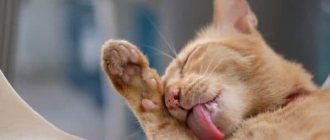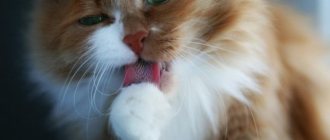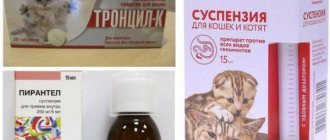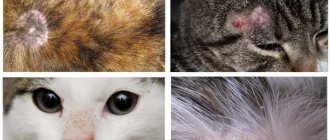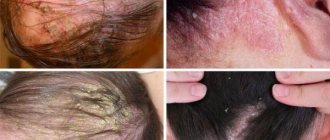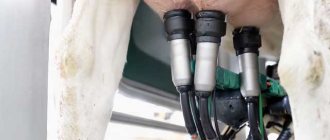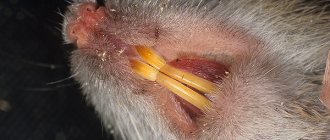I wonder why a cat constantly licks itself and scratches itself. Have you ever asked yourself a similar question? If this happens occasionally, then this is normal. But if you notice that your pet does this too often, you need to become more vigilant.
The skin is the only organ for which the appearance and characteristics are presented in the proverbial palm. It does not take much time to assess the condition of the skin membrane. At the same time, it can provide extensive information not only about itself, but also about the functioning of the entire organism as a whole.
This is a real storehouse of knowledge about the quality of health of our animals, because so far nothing alarming has happened, the skin is also without complaints. However, at the moment when it begins to hurt, you should pay attention to these symptoms, as this may indicate a disruption in the functioning of other organs and systems.
What is itching
One of the most common, most prominent and most annoying symptoms of skin diseases is itching. You need to understand what kind of phenomenon this is and what factors are responsible for its occurrence. Itching is a term used to describe an unpleasant sensation arising from the skin, leading to scratching and rubbing. This is one of the signs of skin diseases, which, however, can be accompanied by other infections.
If we talk about duration, we can highlight:
- Itching is acute (lasting less than six weeks),
- The itching is chronic (lasting more than six weeks).
Short-term itching is a defense mechanism (just like acute pain), indicating that “something is happening” in a given area of the skin. For example, as a result of an insect bite, cats begin to scratch the area to remove the parasite from its surface. Another thing is chronic itching. It may be accompanied by more serious medical conditions.
It is worth noting that the feeling of itching in cats can vary depending on the time of day, skin condition, body temperature or extreme stress. The threshold for the perception of itching decreases (which means the animal becomes more sensitive to irritants) in the following cases:
- At night. During this period, the influence of factors on the body decreases (for example, pain, touch, cold, heat), and therefore the need to itch disappears.
- At elevated skin temperature.
- With reduced skin hydration, dry skin itches more.
- With factors stimulating the mental state, in states of stress. Opioid peptides are then released, which can increase the itching sensation.
Some of the more common symptoms of itching in cats are:
- scratches,
- licking skin and fur,
- gnawing,
- chewing various parts of the body (for example, paws, tail),
- complete or partial hair loss,
- baldness,
- self-harm,
- dermatitis.
These animals are very reserved, which means it is very difficult to guess why the cat is constantly licking itself and scratching itself. Therefore, pay attention to the unusual behavior of your four-legged friend, such as:
- Rolling from side to side,
- Sounds that are more intense than usual
- Shaking your head
- Frequent demands for affection, with the itchiest areas of the body exposed.
If your cat has worms, read the article on how to get rid of them.
[custom_ads_shortcode1]
Hormonal changes
Itchy cat skin also occurs due to disruption of the endocrine system. Excessive licking and scratching causes a cat to develop symptoms similar to those described above: bald patches, dandruff, matted fur. Only a veterinarian can determine what hormonal disorders a cat has. He prescribes the necessary therapy in combination with a therapeutic diet.
Causes of itching in cats
Reasons for constant scratching in cats
As mentioned above, there is a huge list of prerequisites that lead to a cat licking itself intensively. And you don’t need to think that the well-known proverb “to the guests” applies here. This can be a sign of very serious systemic diseases. In many cases, the condition of the skin and its diseases are only the visible cause of a problem hidden deep in the body. It is often very difficult to determine what causes the need to scratch in cats. The most common factors are shown in the table.
| Cause | How it manifests itself |
| Bacterial infections | Changes that accompany infections are:
There may be a characteristic purulent exudate that sticks to hair and envelops the skin in certain places. |
| Fungal | Ringworm in a cat is contagious; it can be picked up through direct contact with a sick animal or its environment (cage, combing brush, etc.). Itching is not a constant symptom of this disease. Clinical manifestations are varied and varied, with varying degrees of alopecia, erythema and scaly formation predominating. The changes are usually located on the face, head, neck and limbs, but it happens that they are also present on the body. |
| Parasites | Mites live in the stratum corneum of the epidermis without penetrating the hair follicle. The disease occurs with severe itching and peeling of the upper areas of the skin. Dandruff appears on her. These parasites are located on areas of the body covered with delicate skin, especially in the vicinity of the eyes, lips, abdomen, external genitalia, legs, head, ears. |
| Allergic street dermatitis | The most unpleasant discomfort and hypersensitivity reaction occurs due to antigens contained in the saliva of fleas. Why does a cat constantly lick itself and scratch itself if it has access to the outdoors? This allergic dermatitis is very difficult to diagnose. Even if you take care of your pet and constantly apply medications that prevent the spread of fleas, the presence of this disease cannot be completely ruled out. |
| Food allergies | Food allergies are a reaction of the immune system to certain proteins contained in food. It appears regardless of age and breed, but Siamese and Burmese cats are more predisposed. Main changes: itching of the facial part of the muzzle, head, neck, symmetrical baldness, dermatitis. In this case, it is better to feed the kitten vegetarian food. |
| Atopy | The disease is congenital, during which a hypersensitivity reaction develops after exposure to some environmental allergen. The main one is house dust mite, the secondary ones are flower pollen, desquamated epidermis, and mold. Additional symptoms may appear: rhinitis, cough, shortness of breath. |
| Increased sensitivity to insect bites | Occurs with the formation of skin changes and swelling of varying degrees of complexity: the ridge of the nose, changes in the sense of smell, ears and around the ears. Symptoms disappear after eliminating mosquitoes from the cat's environment. |
[custom_ads_shortcode2]
Dangerous symptoms: what to look out for?
By nature, pets are quite clean. Especially cats, which can groom their fur up to 10 times a day or more. It seems to us that the cat is constantly licking itself, although there are no fleas, but in fact it is performing a hygienic ritual laid down by nature.
Also, do not forget that the hair of dogs and cats is subject to natural shedding. Moreover, it does not happen twice a year, but almost constantly. It’s just that in spring and autumn the pet sheds more intensely, and we notice this process - the cat, dog itches and hair falls out, although there are no fleas. Active hair loss is also observed when the coat changes in young animals and after the end of lactation in adults.
The shedding process causes particular problems for long-haired pets and those with thick hair. In the absence of adequate care (combing) during this period, the animal’s fur can fall off, curl into cords, and form tangles, which causes discomfort to the animal. While experiencing it, the dog or cat also itches.
Simple observation of the pet, as well as a careful examination of it, will help to distinguish natural processes from the symptoms of the disease. You should pay attention to the presence of such dangerous signs as:
- redness;
- swelling;
- wounds, scratches, deep scratches, scabs;
- pimples, rashes, blisters, pustules;
- unpleasant odor;
- brown discharge from the ear;
- hairless areas of skin;
- profuse dandruff, etc.
You should be concerned if a dog or cat itches, licks, bites itself, rubs against furniture and rolls on the floor. And also if the pet suddenly becomes lethargic, refuses to eat, drinks a lot, sleeps poorly, whines or meows pitifully. All these signs may indicate the development of a pathological process. Therefore, without wasting time, you need to make an appointment with a veterinarian. Describe your problem to him in detail and a specialist will find out why this is happening.
Treatment of symptoms of scratching in cats
Before starting therapy, you need to determine the threshold of excitability of your four-legged companion. This means that if a cat's blood pressure is too high, he may not respond to the itch at all. And in many cases, a certain factor will not be enough to cause the feeling of the need to scratch. But when another stimulus is added to it, the threshold will be reached, and the cat will begin to lick itself more frequently. To simplify, we can say that the clinical manifestations of itching depend on both allergic and non-allergic factors.
Itching appears only after adding several stimuli and exceeding the sensitivity threshold. Sometimes conventional treatment for complications can keep the cat below these limits, leaving the underlying allergic reaction asymptomatic. Therefore, the use of potent drugs is not always effective; you must first find out the causes before treating complications.
The market offers a whole host of different forms of drugs for topical use. The range is very large, for example:
- shampoos,
- ointments,
- gels,
- drugs such as spot-on,
- foam,
- blush,
- lotions.
What are the indications for local treatment and why treat immediately with tablets? Its advantages are as follows:
- Does not burden the body as a whole
- They are applied directly to the sore spot (the skin membrane is fully accessible, unlike other organs to which we do not have direct access).
- More gentle on the body
- No side effects
Do not immediately reach for strong and aggravating medications. It is clear that determining the reason why a cat constantly licks itself and itches is very difficult, the diagnostic road is painstaking. But use a softer method of treating the animal, while simultaneously persistently searching for the causes of the disease.
Most cats are meticulous about the condition of their fur.
A cat spends 30-50% of its time on its hygiene procedures, but what if the pet licks itself to the point of insanity?
[custom_ads_shortcode3]
How to get rid of cat allergies?
Unfortunately, this disease cannot be completely cured. You can only reduce the frequency and severity of symptoms. And there is a way to do this:
- Take medications - this option is suitable for those who do not have a cat at home, but have contact with the animal at work, at a party, or on the street. Antihistamines, aerosols, and nasal sprays can help relieve symptoms and prevent attacks.
All these treatment methods are prescribed by a doctor after diagnosis. You should not self-medicate; it is better to turn to professionals. Thus, at the AllergoCity clinic, qualified doctors - allergists and immunologists - conduct consultations. Patients are received daily, including weekends and holidays. Our specialists make home visits, where they conduct an examination, give advice, prescribe treatment and can even take tests.
Is this normal if fleas have nothing to do with it?
Because cats spend so much time keeping themselves clean, owners don't notice the problem coming. Cleanliness is not the only reason for washing cats. With its tongue, the cat evenly distributes the sebaceous secretion secreted by the skin.
When exposed to sunlight, it turns into vitamin D, making the coat soft and protecting the skin. Neatly laid fur provides the cat with the usual thermoregulation.
The cat is licking itself. Burning and itching of the skin becomes an alarm bell, the cat itches until it hurts and hair falls out along its back or belly. Excessive hair loss due to prolonged brushing is not normal. By scratching the skin with its rough tongue or sharp claws, a cat can cause an infection. Concomitant infection will increase licking, leading to a vicious cycle.
Important! If a cat endlessly scratches or licks the same area, it will cause acute moist dermatitis (hot spots), although dogs are more susceptible to this condition.
The usual culprit for scratching in cats is parasite bites, but why does a cat itch if it doesn't have fleas and ticks?
[custom_ads_shortcode1]
Inflammatory processes that cause cats to itch
An obvious pathological factor that provokes constant itching of the skin in an animal is an active inflammatory process. It can be both local and systemic. The most well-known diseases in cats accompanied by an inflammatory process:
- Otitis. If this disease is present, the cat constantly scratches its ears and is very irritable because it suffers from severe pain. The solution to the problem will be the use of drugs that reduce the intensity of the inflammatory process in the designated location;
- Pyoderma. Pyoderma in animals is manifested by purulent inflammation of the skin provoked by coccal bacteria. The cat's epithelium is deeply affected and cannot be treated with local remedies: antibacterial therapy is required under the mandatory supervision of a veterinarian;
- Secondary bacterial infections. They occur after insufficient aseptic treatment of wounds, cuts, and surgical sutures. Treated with broad spectrum antibiotics.
Causes
For a number of reasons, increased licking and combing of fur becomes obsessive, irritating not only the pet, but also its owner.
- Allergic dermatitis. Skin irritation is an aggressive response of the cat's immune system to food or environmental factors.
- Bacterial and fungal infections. A weakened cat's body and lack of vitamins can increase the number of pathogenic microorganisms. Itchy inflammations and ulcers appear on the skin, and the cat feels unwell.
- Skin diseases (pyodermatitis, cheyletiellosis, demodicosis, scabies) can be contracted by a pet through contact with street animals.
- Hormonal imbalances cause rashes and severe itching.
- Dry indoor air or an unbalanced pet's diet can cause peeling of the skin. In search of relief, the cat begins to lick the itchy areas.
- A cat may lick the same area if it experiences pain or discomfort in that area.
- Obsessive-compulsive disorder is more likely to develop in indoor cats that are bored, anxious, or restless than in outdoor cats. Compulsive disorders arise as a result of changes in the cat's stable lifestyle. These may include moving, getting another animal, or having a child. Often this cat behavior persists after medical intervention.
Something itched. Important! If viruses and bacteria are the cause of a cat's frequent scratching and licking, the owner should maintain personal hygiene and thoroughly wash their hands after each contact with their pet.
[custom_ads_shortcode2]
Special diet for a cat suffering from itching of various etiologies
Regardless of the cause of the itching, it is worth transferring the cat to a special anti-inflammatory diet during treatment. Feeding the right foods will not only reduce the intensity of itching, but will also prevent relapses (if the cause was a food allergy).
If before the outbreak of the disease the animal ate exclusively feed, then it is worth purchasing a hypoallergenic variety. If the cat ate “human” food, then it is necessary to eliminate porridge, potatoes, and pork from the diet.
For some time it is better to feed the animal vegetables and fish. You can also supplement your diet with a teaspoon of regular butter. Supplementing with fish oil containing omega-3 and omega-6 will also help reduce itching. In general, fatty acids eliminate inflammation from within the body. Suitable sources of omega-3 are:
- krill;
- salmon;
- tuna;
- anchovy;
- sardines.
Naturally, fish by-products or canned food can be used to feed the animal. The most important thing is to monitor the condition of the animal’s skin daily and promptly adjust the diet and treatment.
Diagnosis and treatment
The cat’s obsessive and acute desire to scratch itself and lick its fur requires an integrated approach to solving this problem. So what should an owner do if the cat is constantly itching and licking itself?
- First, determine what caused the cat's behavior . Most often, itching is caused by flea bites. In this case, the pet is examined for parasites. If fleas are found, the cat is treated with flea products, and the discomfort that plagues her will be eliminated. If your pet is not afraid of water, you can bathe him with anti-parasitic shampoo.
- If the owner suspects that the cause of annoying licking is a food allergy, he should review the cat's diet and eliminate potential allergens from it.
- Eliminating anxiety and restlessness lies entirely on the shoulders of the cat owner. The pet should feel comfortable and safe in the house. Perhaps the result will be brought by slow and careful desensitization of the cat. It is important to show her that an object that causes negative associations in her is not dangerous or can be useful. There is no need to rush; any sudden steps can increase the cat’s anxiety and, as a result, increase licking and scratching. You can use the counterconditioning method to teach the cat to associate the object of fear with something positive. This will help relieve her of stress and anxiety. You can bring objects familiar to the cat to your new home or install a multi-level shelf, on top of which the cat will feel safe.
- If the owner is unable to independently determine the cause of the cat’s pathological licking, he should take the pet to the veterinarian . It is better to provide timely assistance to your pet than to treat concomitant diseases later.
Important! Only a doctor can prescribe competent drug treatment and dosage of drugs. Ineffective treatment can lead to complications.
None Depending on the nature of the skin damage, the veterinarian may prescribe hormonal therapy, antihistamines and antibiotics.
Neurosis, obsessive-compulsive disorder and mental disorders in cats are treated with antidepressants that have an antihistamine effect.
[custom_ads_shortcode3]
Therapy
You cannot treat a cat that is constantly licking and itching on your own. The diagnostics carried out reveal the true reason for this behavior. And based on it, the veterinarian prescribes a certain set of drugs. Therapy is divided into two groups:
- Etiotropic. The action is aimed at eliminating the cause that causes itching. The most effective option.
- Symptomatic. Treatment is aimed at controlling symptoms, particularly itching. It is temporary. Ineffective.
Important! The owner can help the animal if he follows all the veterinarian’s instructions. Stopping or adding medications on your own can cause serious harm to your cat.
Prevention measures
- Limit your indoor cat's contact with street animals. At the same time, do not deprive her of fresh air: you can let your pet out onto the balcony or into a fenced-in space, for example, in the country.
- Timely treat your pet against external (fleas, ticks) and internal (helminths) parasites.
- Inspect the animal's fur and skin.
- Provide a balanced diet and avoid consuming foods that cause allergic reactions.
- Cats feel the manifestation of love and care from humans. You should not allow your pet to experience stress. Any worries and neuroses are the first step towards the development of diseases.
- Regular visits to the veterinary clinic .
[custom_ads_shortcode1]
Infection with helminths as a cause of itching
Helminth
Helminths, if not regularly combated, can significantly annoy your pet, undermining its health from the inside.
The consequences of the vital activity and reproduction of worms in a cat’s body can be many troubles that bring suffering to your pet no less than fleas:
- The cat feels discomfort in the anus, itches and licks it;
- her stool and digestion are disrupted, her appetite is distorted;
- the coat becomes dull and the skin becomes dry and flaky;
- eyes turn sour;
- behavior becomes abnormal: apathetic or, on the contrary, excited.
Even the smallest kitten can suffer from worms if it is infected from its mother.
To prevent infection with worms, regularly clean with anti-helminth medications.
Fleas
This is perhaps the most common reason that a cat scratches and licks itself all the time, especially in the area above the tail and on the paws. These parasites can even appear in pets, so no one is safe from them. At the same time, if you do not see small black dots on your cat’s fur, this does not mean that there are no fleas.
They can still be very tiny (nits) or simply in the form of eggs on the fur. However, their vital activity will already cause enormous inconvenience and discomfort to the pet.
[custom_ads_shortcode3]
Symptoms
Different people may experience different symptoms and with different severity. Most often, an allergic reaction manifests itself in the form of:
- Nasal congestion and/or runny nose
- Coughing, sneezing, shortness of breath
- Itching/burning/swelling of the nasopharynx
- Inflammation, swelling of the eyes, lacrimation
Direct skin contact may cause:
- Itching and burning
- Irritation and dryness
- Rash/redness
If the allergen gets into the stomach, which often happens in children, the reaction appears in the form of:
- Nausea
- Stomach pain
Other parasites
In addition to fleas, your cat may develop other skin parasites that can cause anxiety and discomfort. The pet will also itch and lick itself a lot. A clear sign of the presence of any parasites is if the cat tries to gnaw something out of its fur.
The animal intuitively tries to remove annoying enemies in this way. The most common of them are lice and ticks, which in turn are also dangerous because they carry infections and viruses.
[custom_ads_shortcode1]
What should the owner do if the cat is itching and licking?
Owners are usually alarmed if a domestic cat frequently licks and scratches itself. And such problems must be resolved immediately. Otherwise, the animal’s behavior will lead to the appearance of deep wounds and scratching. And they are dangerous due to the penetration of pathogenic fungi and bacteria.
There are many reasons for such symptoms. This means that looking for them on your own is pointless and even dangerous. In order not to waste time, the best solution is to contact a veterinarian.
Important! The maximum allowable help from the owners is to treat the pet for worms and fleas. If the animal continues to itch all the time, you need to contact a veterinarian.
Allergy
If you regularly treat your cat's fur for parasites and the veterinarian's analysis does not show their presence, the cause of the itching may be an allergy. Pedigree cats and cats suffer from it especially often. This may be, like in humans, a manifestation of sensitivity to food, furniture upholstery, or some chemical component. A particularly clear sign of an allergy is when a cat licks itself heavily, thus trying to scratch its nose and lips.
Allergies can be not only to food components, but also seasonal or, for example, to dust and pollen. It is important to get tested and identify the irritating allergen as soon as possible.
[custom_ads_shortcode2]
general information
Condylomas are a benign tumor formation that is “located” on the epidermis or mucous tissues and looks like warts and papillae. Single specimens (about 7 mm) or entire “colonial formations” (up to several tens of mm) of condylomas settle on the body of women and men and often resemble cauliflower in appearance. The color of these substances ranges from flesh-colored to brown. Condylomas are viral in nature, so such problems can even occur in children (during childbirth from an infected mother). As long as the growth has not reached the epidermis, the person does not pose a threat to others; the risk of infection increases if the growths are located in the epidermal layer. Condylomas are usually divided into two types:
- wide;
- pointed.
In the first case, condylomas in women and men look like a mushroom with a cap and a wide stalk and are most often a consequence of secondary stage syphilis. Condylomas of the genital type are transmitted through sexual relations; the human papillomavirus (HPV), which is activated under certain conditions, is involved in their appearance. The main location of genital warts is the genitals and oral cavity. Condylomas in women settle on the outer and inner parts of the labia, in the vagina, clitoris and anus. Warts and papillary growths in men select the glans penis and frenulum of the foreskin.
Bacteria and fungi
Various microflora live on the skin and in the body of any even healthy animal. But if the cat’s body is weakened, experiencing some kind of stress, lack of vitamins, etc., this can cause an increase in the amount of pathogenic microflora. Because of this, various types of skin inflammation, rashes, itching occur, and the pet’s general condition worsens.
Most often, the cause of this phenomenon lies in bacteria and all kinds of fungi. By the way, they can also be transmitted through human hands, because the cat constantly licks itself.
[custom_ads_shortcode3]
Lice, lice, mites and other external parasites that cause itching
These unpleasant “guests,” including fleas, are called ectoparasites. All of them provoke severe itching, flaking of the skin, and hair loss.
The cat is forced to literally scratch its skin, injuring local and large areas.
If treatment is not started in time, secondary inflammation, suppuration, sepsis and baldness may occur.
The most dangerous and difficult for cats are:
- ear scabies - a mite that settles in the external auditory canal;
- sarcoptic mange, which affects various parts of the cat's body;
- notoedrosis, localized mainly on the face.
The animal is experiencing serious suffering, so it is better to begin treatment as soon as possible.
Skin diseases
As a rule, they are all infectious in nature and occur after a pet comes into contact with an infected object. Sometimes it is enough for a cat to go outside just once to pick up some kind of infection. Often, diseases such as pyodermatitis, cheyletiellosis, demodicosis, and scabies occur.
They are also caused by mites that parasitize the upper and deep layers of the skin. Severe itching in the first stages very quickly develops into general skin damage and baldness.
If a cat's skin problems are detected, the cat owner needs to thoroughly wash their hands with soap and maintain personal hygiene, since many viruses and bacteria can be transmitted to human hands.
[custom_ads_shortcode1]
How to live with a cat if allergies are confirmed?
Based on the diagnostic results, it turned out that your body reacts specifically to the cat, but you do not want to part with your pet. What to do? By following a number of recommendations, you can reduce the likelihood of exacerbation of allergies:
- Try to pet the animal less, do not kiss it. After being held, wash it with soap.
- Regularly give your cat water treatments and brush her
- Replace the open tray with a closed one
- Do wet cleaning as often as possible, at least twice a week
- Don't forget to ventilate the rooms several times a day.
- Air washers will help clean the room from flying microparticles
- If possible, remove all carpets, bedding, and soft toys. Put things in the closet immediately
These rules will help you get along with your tailed friend in the same house. But their observance requires care and patience.
Treatment
If you notice that your cat is constantly itching, licking itself, and at the same time acting restlessly, hitting its tail, you should immediately take your pet to the veterinarian. It is better not to try to establish the cause and diagnosis yourself, since many of the symptoms are similar to each other. Laboratory analysis and proper examination will be required.
If the reason that the cat is constantly itching, licking and licking itself lies in fleas and other skin and fur parasites, then external treatment is prescribed. The veterinarian may prescribe special drops or sprays, or recommend treating the animal with medicated shampoo. As a rule, using all these drugs several times helps to quickly remove itching and irritation and overcome parasites. In the future, only timely prevention will be required.
If the skin ailment is caused by an infection or fungus, medicinal sprays and drops will also help in the early stages. But, as practice shows, special medications and antibiotics may still be required. If the cat is constantly itching, licking its face, scratching its ears and eyes, antihistamines are prescribed. An accurate analysis is performed and the source of the allergy is determined.
[custom_ads_shortcode3]
Why is itching dangerous in a cat that is not affected by fleas?
If your cat is constantly licking itself and scratching continuously for several days, then it needs immediate treatment. After all, a careless bite can cause a serious infection in small wounds. First of all, you need to check whether fleas or other parasites are visible to the naked eye. If there are no signs of infection, you should urgently consult a veterinarian.
Only a professional will determine the true causes of the problem, which may include:
- scabies;
- demodicosis;
- notoedrosis;
- pyoderma;
- ear infections.
Veterinarian advice
It is no secret that many parasites and viruses are transmitted from one animal to another, through the hands of people, but you should not be afraid and limit the freedom of a cat. Of course, there is no need to throw your pet into a pack of stray cats, but letting it out for a walk on the balcony or in the country is quite possible. Like any animal, cats also need fresh air and sun. It is enough just to keep the animal clean and carry out timely antiparasitic treatment.
Do not forget about a proper and balanced diet, which is also the key to your pet’s health. If he has a strong immune system, then no infection will be scary to him. Do not feed prohibited foods, sweets, salty and smoked foods.
All this can cause or provoke the occurrence of food allergies. Pay attention to when your pet licks.
And finally, the last piece of advice is love and affection. Remember that your cat is a living creature that needs your care and attention. A change of owner or a change in your behavior can cause stress in your pet. And stress, as you know, is the first step to illness. If you want to pet an animal, but it is nervous and wags its tail, it is better to leave it alone, do not squeeze or pick it up without the desire of the pet itself. Remember that he also has the right to peace and rest.
Sorry, there are no surveys available at this time.
[custom_ads_shortcode1]
A must read!
Here were listed the main causes of itching that cause a cat to have a terrible desire to scratch. But there are many more reasons! It may well be that your pet licks its fur simply because it wants to scratch. But in any case, you need to monitor his behavior, namely, scratching, scratching and biting his own limbs.
To prevent the itching from returning, you should get rid of the cause rather than treat the symptoms. And for prevention, we recommend that you properly care for your cat and keep your beloved pet’s skin clean.

